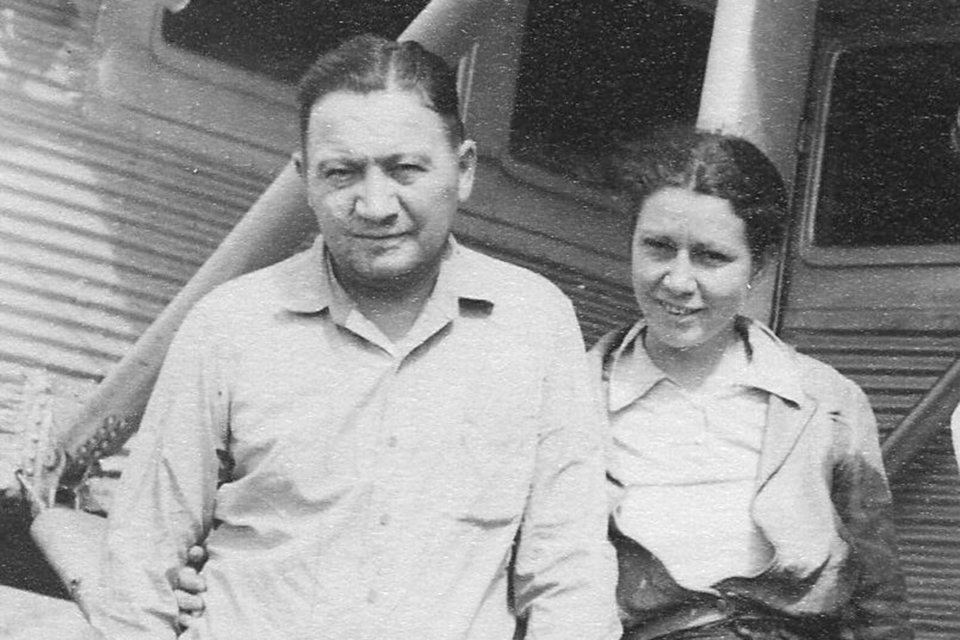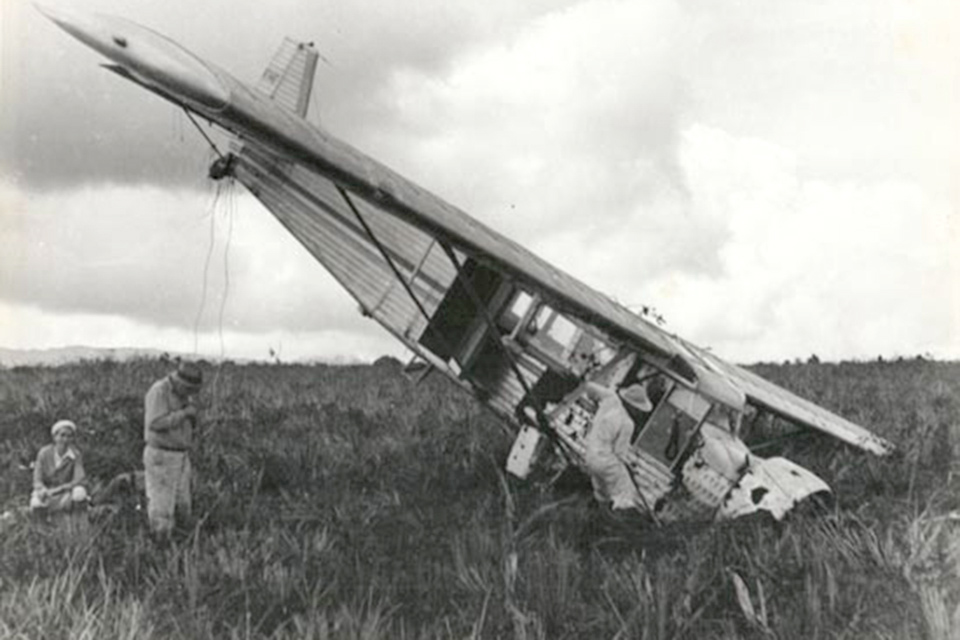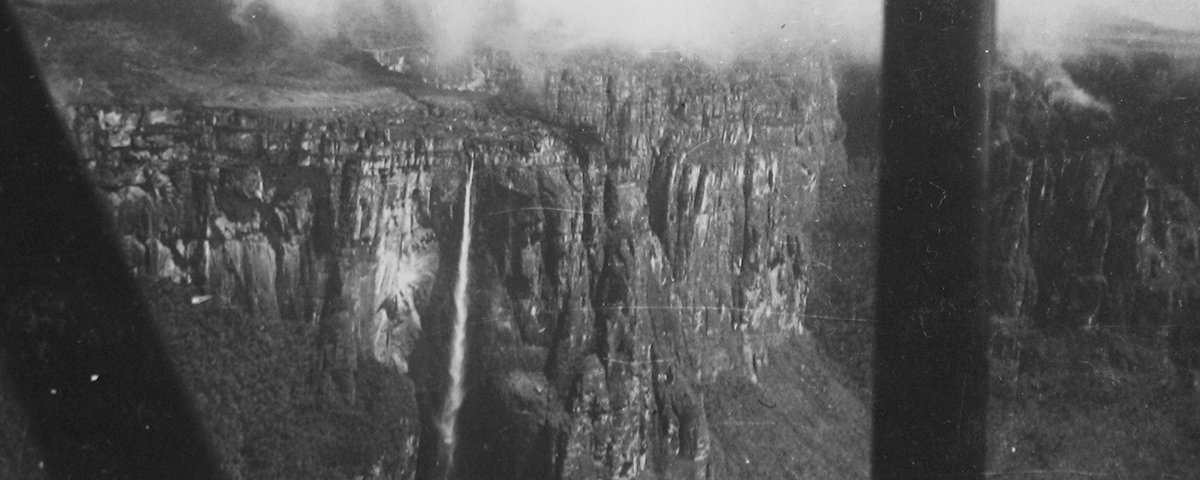Jimmie Angel searched Venezuela’s “Lost World” for a fabled river of gold, but all he found was a waterfall—the world’s tallest, as it turned out.
Pilot and adventurer James Crawford Angel lived a life of contradictions in which reality sometimes blurred with fiction. Angel loved to spin tales almost as much as he loved flying. “He actively participated in the creation of the various legends about his colorful life,” acknowledges his niece Karen Angel, who has dedicated years to tracing his career.
Born in southwest Missouri in 1899, Jimmie Angel claimed he taught himself to fly at the age of 14, one of the stories about him that cannot be verified. By the early 1920s, he was barnstorming across the country with a flying circus featuring himself and his brothers as pilots, along with wing-walkers and parachute jumpers. Jimmie’s wife, Virginia, also performed stunts, as did the brothers’ wives.
Jimmie also worked as a flight instructor, test pilot and movie stunt pilot, but he brushed off suggestions that he fly for an airline. “It would be like driving a bus,” he explained. Though stories have surfaced that he became an ace during World War I, created an air force for a Chinese warlord in the Gobi Desert and served as an aerial scout for Lawrence of Arabia, Karen Angel has found no evidence to support them.
Jimmie eventually became obsessed with finding a “river of gold” he believed existed in Venezuela’s Gran Sabana wilderness. He often told a story about his encounter with an American prospector named McCracken in a Panamanian bar early in the 1920s. The prospector said he’d heard that Jimmie could land on a dime, and offered him $5,000 to fly him to a gold-filled river in the Gran Sabana. The two men outfitted an airplane and headed for the uncharted wilderness, where McCracken had Jimmie land on a tabletop mountain. They found stream beds glittering with golden ore, some of which they loaded onto the plane. By that time night was falling, and they had to take off for the Ciudad Bolivar airport 160 miles away.
The story concludes with the pair returning to Panama, where McCracken paid Angel his fee. But the prospector fell ill and died before they could return to the mountain, leaving the young pilot to try to figure out exactly where they’d found that river of gold.
Jimmie’s description of his adventure varied through the years, and whether it was based in fact is debatable. Karen Angel categorizes her uncle’s oft-told tale as unverifiable, noting that it “was sometimes a successful means of attracting investors to his search for gold.”
In 1933 Jimmie returned to the Gran Sabana in his TravelAir, accompanied by two representatives of a Tulsa oil company. Though they returned without any gold, Jimmie made another discovery while flying solo in the area: a “mile-high waterfall” plunging from Auyantepui, a towering plateau whose name means “the Devil’s House.”
“Found myself a waterfall,” he recorded in his logbook on November 18. His discovery wouldn’t be verified until years later, at which time the fan-shaped torrent was measured at 3,211 feet, with a 2,648-foot main drop—making it the world’s tallest waterfall, 15 times higher than Niagara Falls. The Venezuelan government would name the falls in Angel’s honor in 1939.

Meanwhile, Jimmie and some partners bought a rugged, single-engine Metal Aircraft Corporation Flamingo that could carry seven, which he dubbed El Rio Caroni, after the Venezuelan river he used as a navigational lifeline through the Gran Sabana. He also acquired a new wife, Marie Sanders, who sometimes served as his copilot and navigator. In the fall of 1937, she accompanied Jimmie and Gustavo Heny, a wilderness explorer; his servant Michael Delgado; and botanist Felix Cardona Puig on another expedition. They planned to land atop Auyantepui and search for the mother lode.
The group scouted the mountain for several days, roughing out a trail from a base camp to the summit and dropping supplies on the plateau. They finally attempted a landing on the mountaintop on October 9, which went smoothly until the landing gear began to bog down. “Pull out, Jimmie! Pull out!” Heny shouted, seconds before the aircraft nosed over and lurched to a halt. The party spent two days searching fruitlessly for gold before starting the trek down the mountain. Along the way they left notes for potential rescuers, who flew over the mountain but didn’t spot the mired aircraft. Ten grueling days later the team reached the base camp. “This madness for gold sure gets people into some awful predicaments,” commented Marie Angel.
That mishap meant Jimmie couldn’t participate in a subsequent expedition mounted by the American Museum of Natural History, inspired by his earlier explorations. After three months spent documenting the region’s flora and fauna, the researchers emerged in March 1938 with a treasure trove of data and specimens, including 507 mammals, 243 fish, 2,039 birds and 150 insects and spiders. Despite Angel’s absence from that team, they praised his efforts to explore the region. “I believe that Jimmie Angel has discovered the eighth wonder of the world,” ornithologist E. Thomas Gilliard wrote in the July 1941 Saturday Evening Post. Naming Angel Falls after the pilot, he wrote, made it “a monument to the courage and persistence of this explorer-aviator and soldier of fortune.”
Jimmie and Marie returned to the Gran Sabana in March 1939, flying a newly purchased single-engine Hamilton Metalplane, and agreed to join an expedition mounted by the Venezuelan Ministry of Development. During five months in the field, Jimmie flew more than 300 hours, mapping, scouting, taking aerial photographs and transporting scientists to remote spots. “He does things that practically no one else would have the skill or the nerve to do, and then takes them so casually that it is hard to believe he did them,” wrote George Gaylord Simpson, who with his wife, Anne Roe Simpson, represented the American Museum of Natural History on the expedition.

Jimmie and Marie were next asked to work with the Venezuelan-Brazilian Boundary Commission, to help establish emergency landing fields and airlift equipment for the Venezuelan government. But authorities revoked Jimmie’s license to fly in Venezuela not long afterward, following an ill-starred errand of mercy. Jimmie had volunteered to airlift a pregnant woman from a backcountry campsite to a hospital in Ciudad Bolivar. When he saw that he lacked fuel to complete the flight safely, he landed on a riverfront beach, flagged down a local in a canoe and asked him to bring fuel.Angel and his passenger arrived at the hospital just in time for the birth. In the meantime, however, the air force had launched a search in which a pilot was killed. Jimmie suddenly became persona non grata in a country he loved.
Through the 1940s the Angel family lived in at least eight locations, mostly in Latin America. Jimmie operated two small air transport companies, one of which hauled raw rubber out of Nicaragua and Honduras. But when both sons, Jimmy and Rolan, developed health problems, the Angels returned Stateside, first to Missouri and later to Santa Barbara, Calif., which became his base for further adventures.
Angel logged his last flight in April 1956, when he and a companion took off for British Guiana. Before leaving, the 57-year old pilot told his father, “Dad, I will not be back.” Landing in Panama in a crosswind on April 17, Jimmie was struck in the back of the head by unsecured cargo. He initially survived the resulting concussion, but died of complications in a military hospital on December 8. The death certificate listed his occupation as “explorer.” Fulfilling her husband’s wish, Marie Angel and her sons flew his ashes back to the Gran Sabana in July 1960 to be scattered over the waterfall that bears his name.
Angel’s Flamingo remained atop Auyantepui for 33 years before the Venezuelan government declared it a national monument and airlifted it out to restore it. Today it sits forlornly outside the airport terminal at Ciudad Bolivar, abused by the weather and vandals. Supported by Venezuelan pilots, Karen Angel has fought unsuccessfully so far to have the plane released by local authorities so it can be better preserved.
Karen leads tours to Angel Falls, and has hiked the trail down from Auyantepui, now within Canaima National Park. She also continues to research her uncle’s life as part of the Jimmie Angel Historical Project (see jimmieangel.org). While acknowledging that Jimmie spent much of his time looking for gold, she emphasizes his efforts as a trailblazer in the region, saying, “His living and his reputation as a master pilot were earned by flying thousands of hours, often in dangerous conditions, for other people in support of their enterprises and dreams.”
Originally published in the May 2011 issue of Aviation History. To subscribe, click here.





